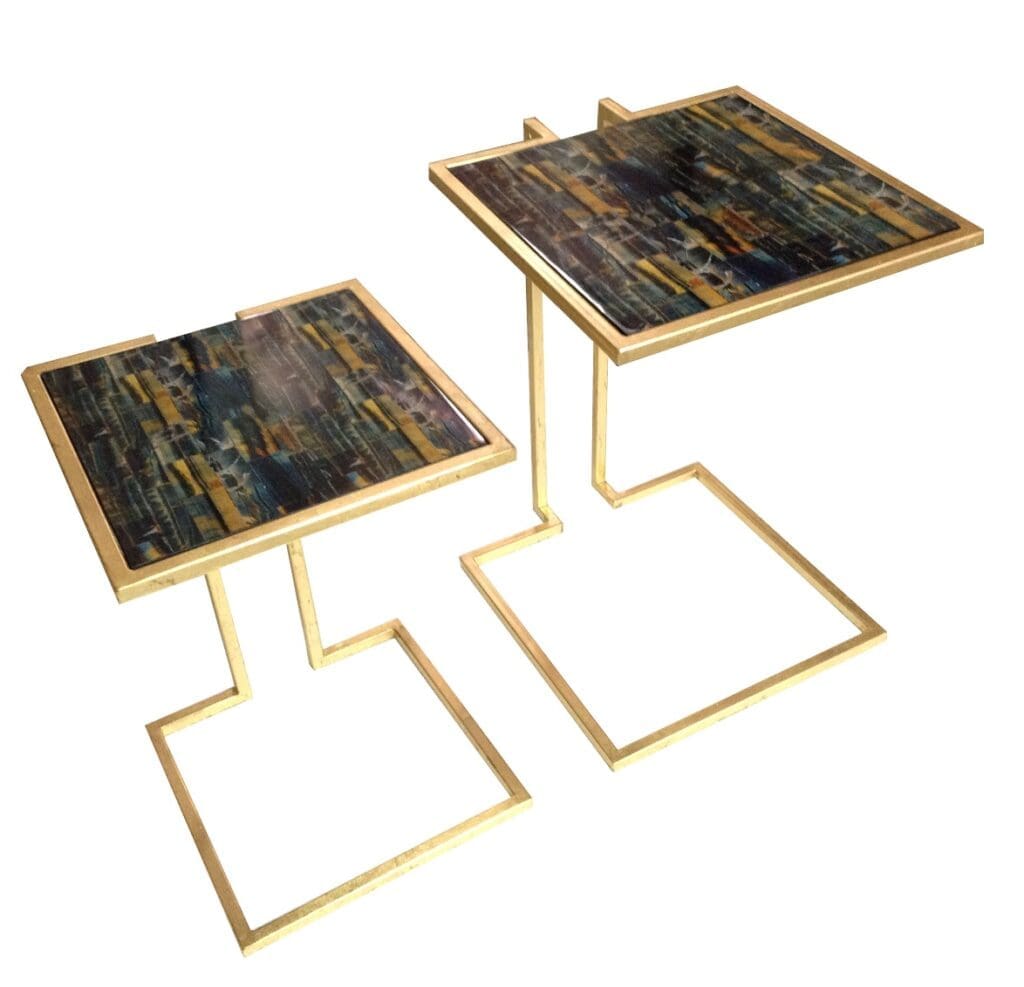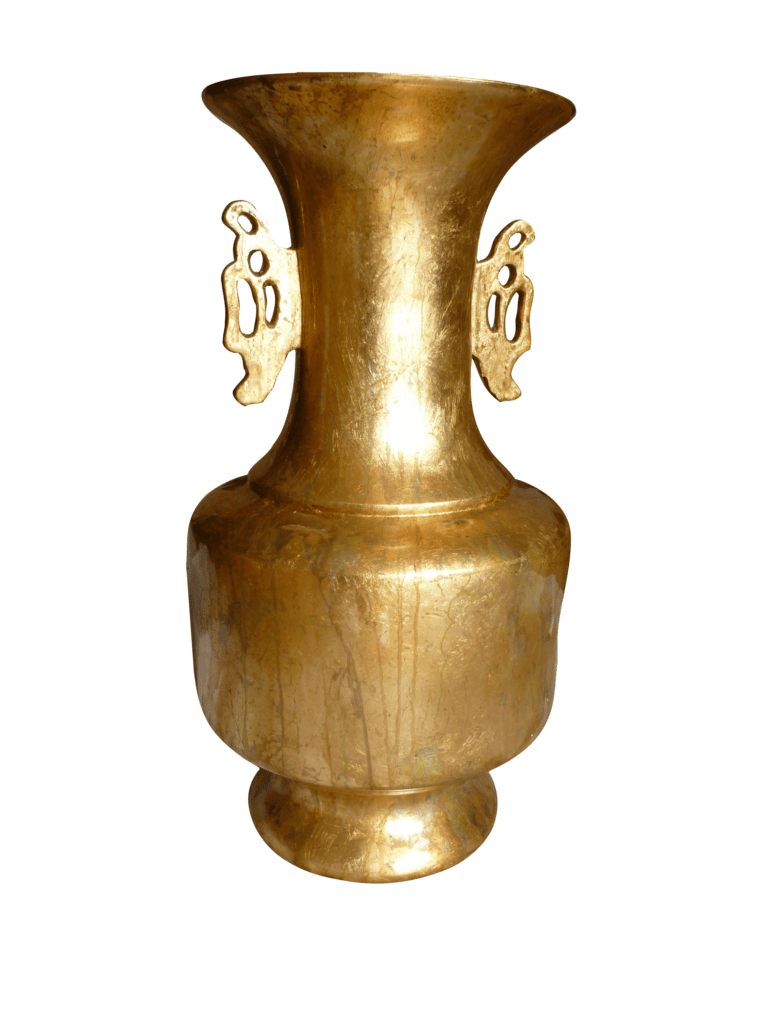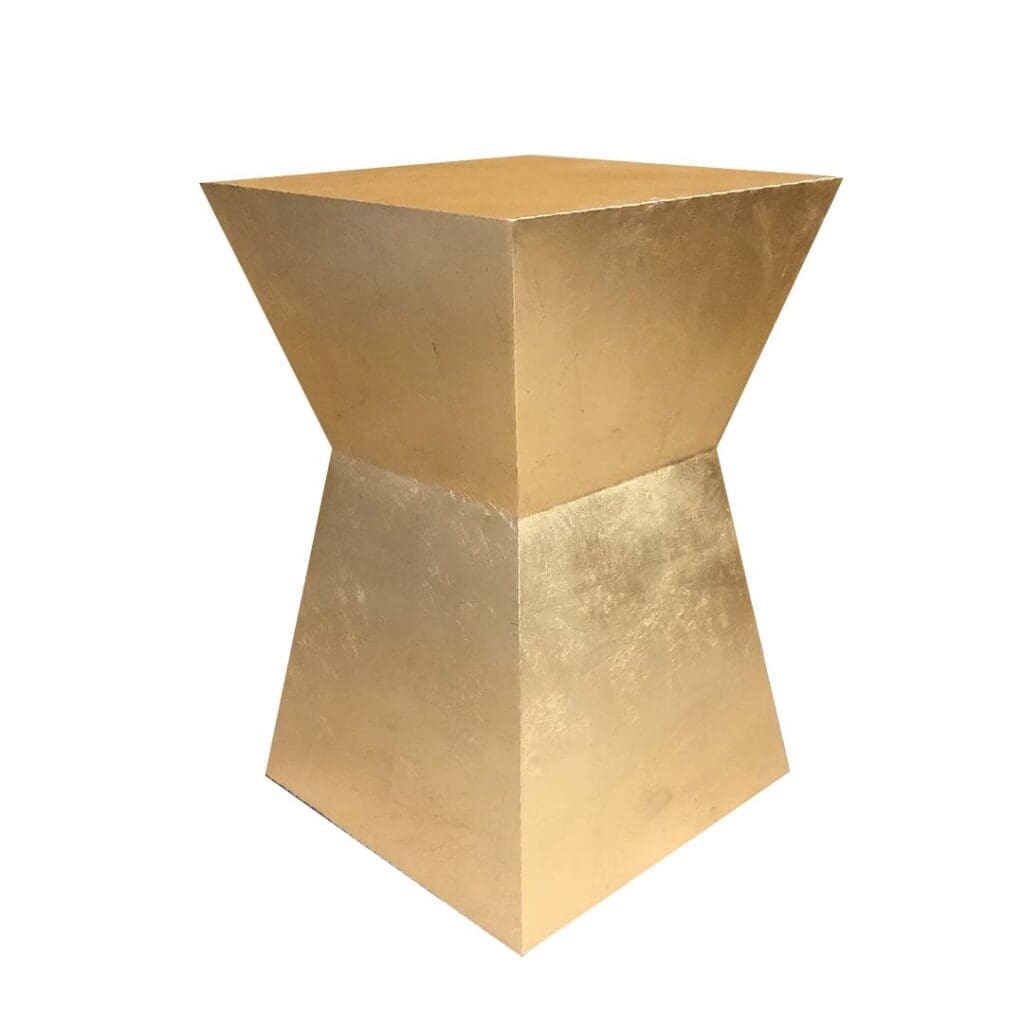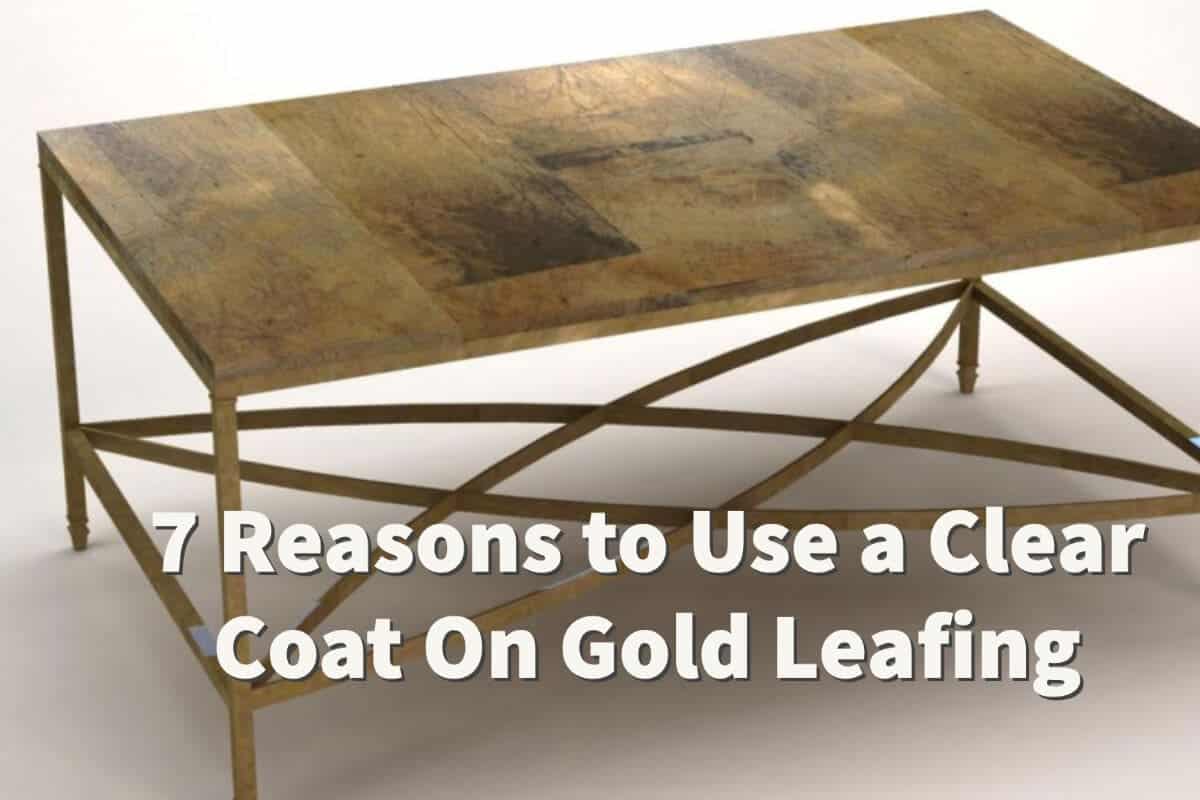When working with gold leaf, many people ask if they should put a clear coat on it or leave it without a clear coat. We use gold leafing in our manufacturing, and we always put a clear coat on our gold leaf.
The gold leaf material is very fragile, so a clear coat will help to protect the gold leaf surface. A clear coat also toughens up the surface and helps slow oxidization. A clear coat on the gold leaf can also help us control the shine level we want on the gold leaf. You can manipulate the gold leaf with a clear topcoat on the gold leaf finish. We find that PU or polyurethane Is the perfect top coat for gold leaf.
Table of Contents
- 7 Reasons Why We Use Polyurethane Topcoat Gold Leaf Finishes
- Unveiling the Elegance: 9 Fascinating Facts About Gold Leaf And Gold Leafing
- Frequently Asked Questions
- Related Content
7 Reasons Why We Use Polyurethane Topcoat Gold Leaf Finishes
Gold leaf imparts a luxurious finish to various materials, but whenever we apply gold leaf, we always seal it with a polyurethane topcoat. Dive in to discover the seven compelling reasons behind our choice of using a polyurethane sealant on gold leaf applications.
Gold Leaf Is Fragile
Anyone who has worked with the gold leaf sheets will tell you that gold leaf is extremely fragile. The sheets are fragile, so even the slightest wind can cause these fine gold leaf sheets to blow away.
Just by the nature of the gold leaf sheets and how fragile they are, we find it always best to have some protection or topcoat on the gold leaf sheets once they apply to a surface.
Protects The Gold Leaf
If the gold leaf finish you are using will have a lot of handling, a clear coat will help to protect the gold leaf surface. We use gold leaf a lot in our Vietnamese lacquerware production, and we always put a clear coat on the gold leaf. This clear coat on the gold leaf helps to protect the gold leaf finish.
When using a 23-carat gold leaf, some artists will not use a clear coat on their artwork. This is because they want to keep the same brilliance and look of the gold.
But we find, whether for our lacquerware or our artwork, that adding a clear coat on the surface helps protect the gold leaf, and if the correct topcoat is used, it will not change the look, shine, or feel of it the gold leaf.
Toughen Ups The Gold Leaf Surface
The correct clear coat will also help toughen up your gold leaf’s surface. This is another reason to put a clear coat on the gold leaf.
The gold leaf surfaces, even gold leaf used for artwork, can have normal wear and tear. Simply putting on a clear topcoat will help make sure the surface will not get ruined and help toughen up the surface. This is why we use a clear coat finish on all gold leaf products, as it will toughen up and protect the surface.

Helps Control Oxidization
Gold is a metal, and as a metal substance, oxidation will occur. There is no way to control how fast or slow the oxidization will occur or even if it will occur everywhere or just with part of the gold leaf.
But if exposed to air, oxidization can come sooner than with a clear coat on the gold leaf. Temperature, humidity, human sweat, and perspiration can all affect gold leaf oxidization.
Some people really like the oxidization look, and others do not. But the point here is that oxidization is something that can not be easily controlled.
A clear coat on the gold leaf will help slow down the oxidization process as the gold leaf is not exposed to air, but even a clear coat can not fully eliminate oxidization.
Controls Shine of Gold Leaf
One of the great things that a top coat can do to the gold leaf finish is to help you control the shine of the gold leaf. We do this a lot for our gold leaf production.
For example, we want to have a shiny gold leaf surface, so we spray a shiny topcoat. If we want the gold leaf to look flat or dull, we spray the gold leaf finish with a matt topcoat. So by having a top coat on the gold leaf will also allow us to dictate what kind of shine the gold leaf finish will have.
This is another advantage of having a top clear coat on the gold leaf finish; it allows us to control the surface shine and the final product’s appearance.
Can Put Elements On the Gold Leaf
A top coat on your gold leaf also allows you to put other elements on top of the goldleaf, such as paint, wax, chemicals, or textures. This means the color of the goldleaf itself is not limited, but you can use wax, varnishes, paint, and chemicals to manipulate the gold leaf color and surface.
The ability to manipulate the gold leaf surface is one of the great things about gold leaf, and it means that you are not just limited to the gold leaf look and color, but you can add to the gold leaf to make it a unique finish.

PU Is A Very Good Top Coat
We use mainly PU or polyurethane on all our gold leaf finishes. We use polyurethane because it is a very stable top coat that will last a long time.
Polyurethane usually does not crack or wear down easily. This means that it can be put on a gold leaf surface and will not affect the surface’s look very much but will also last for a long time.
There are many forms and types of PU, but the type of PU or polyurethane that we use is not harmful and is a highly stable gold leaf topcoat.
Unveiling the Elegance: 9 Fascinating Facts About Gold Leaf And Gold Leafing
With its shimmering elegance and history-rich application, gold leaf has long been a symbol of luxury and opulence. Beyond its sheer beauty, there’s a rich tapestry of facts and nuances surrounding gold leaf and the art of gold leafing.

Let’s delve into nine captivating facts that showcase the magic of this age-old craft.
- Ancient Origins
Gold leafing, also known as “gilding,” dates back to ancient civilizations. The Egyptians, for instance, employed gold leafing techniques on statues and tombs as early as 2500 BC. - Paper-Thin Elegance
Gold leaf is astoundingly thin, often just about 0.1 microns thick. This delicate nature allows it to be applied smoothly, creating a seamless reflective surface. - No Oxidation
Gold does not tarnish or oxidize. This inherent quality means that gold leaf retains its radiant glow for years, resisting the usual wear that other metals might exhibit. - Versatile Applications
The application of gold leaf isn’t limited to one substrate. From wood and metal to stone and glass, gold leaf can be applied to a multitude of surfaces, making it highly versatile in the world of art and decor. - A Testament to Skill
Gold leafing is an art that demands skill, patience, and precision. The delicate nature of the gold leaf sheets requires artisans to use specialized tools and even their breath to maneuver and place the sheets perfectly. - Culinary Gold
Beyond decor, gold leaf has found its way into the culinary world. Edible gold leaf, made of pure gold, is used to embellish desserts, cocktails, and even main courses, adding a touch of luxury to gastronomic creations. - Variety in Karats
Gold leaf comes in different karats, with 24k being the purest form. The karat determines the gold’s softness and color, allowing artists to choose the perfect shade and consistency for their projects. - Not Just Gold
While gold is the most popular, leafing techniques can also be applied using other metals like silver, copper, and aluminum, each offering its unique finish and hue. - Historical Significance
Throughout history, gold leafing has been a mark of grandeur. It’s been used to decorate religious artifacts, palace interiors, and artworks, symbolizing divinity, power, and affluence.
Gold leaf and the art of gold leafing stand as a testament to humanity’s love for beauty, luxury, and craftsmanship. With its rich history and enduring charm, this centuries-old technique continues to captivate and inspire, turning ordinary objects into masterpieces of luminous splendor.
At Mondoro, we create, develop, and manufacture home decor and furnishing products. We will always put in several of these silica gel products for our products. These silica gel packets help us ensure the products arrive without any issues.
Find out more about how Mondoro can help you create, develop, and manufacture excellent home decor and furniture products – don’t hesitate to contact me, Anita. Check out my email by clicking here or become a part of our community and join our newsletter by clicking here.
Mondoro gives out a FREE Lookbook to anyone interested. You can receive a copy of our latest Lookbook by clicking here.
Listen to our Podcast called Global Trade Gal. You can find it on all major podcast platforms. Try out listening to one of our podcasts by clicking here.
Subscribe to our Mondoro Company Limited YouTube Channel filled with great videos and information by clicking here.
Frequently Asked Questions
Why should I use a clear coat on gold leaf?
Using a clear coat on gold leaf is essential because gold leaf is fragile, and the clear coat provides a protective layer, preventing damage to the delicate gold surface.
How does a clear coat contribute to the durability of gold leaf?
A clear coat adds toughness to the gold leaf surface, enhancing its durability and making it more resistant to scratches and other forms of wear.
Does a clear coat help prevent oxidization of gold leaf?
Yes, a clear coat plays a crucial role in slowing down oxidization, preserving the luster and appearance of the gold leaf over time.
Can a clear coat be used to control the shine level of gold leaf?
Absolutely. Applying a clear coat allows for control over the shine level, enabling customization based on personal preferences or specific project requirements.
How does a clear coat contribute to manipulating the gold leaf finish?
The clear coat provides a workable surface, allowing for manipulation and adjustments to the gold leaf finish during the application process.
What type of clear coat is recommended for gold leaf?
PU (polyurethane) is highly recommended as a top coat for gold leaf. It provides a protective and durable finish while preserving the beauty of the gold leaf.
Is a clear coat necessary for all applications of gold leaf?
While not mandatory, using a clear coat is highly advisable for most applications. It ensures longevity, protection, and the ability to fine-tune the appearance of the gold leaf.
Does a clear coat alter the color of the gold leaf?
No, a clear coat is designed to be transparent and should not alter the color of the gold leaf. It enhances and protects the gold surface without affecting its visual appeal.
Can a clear coat be applied to both indoor and outdoor gold leaf projects?
Yes, a clear coat is versatile and can be applied to both indoor and outdoor gold leaf projects, providing protection against environmental elements.
How long does the clear coat protection last on gold leaf?
The longevity of the clear coat protection depends on factors such as environmental conditions and the quality of the clear coat used. Generally, a well-applied clear coat can offer long-lasting protection for the gold leaf.
Related Content
What is Gold Leafing Used in Home Decor Products?
The gold leaf is hammered gold. Some gold leaf manufactured today is actually hammered, copper or gold mixed with other metals and alloys. The gold leaf is manufactured by gold beating. The process of gold beating is to beat or press the gold into fragile sheets of paper.
You can discover more by reading What is Gold Leafing Used in Home Decor Products? by clicking here,
What are Vietnam’s French Encaustic Cement Tiles?
The French encaustic cement tile is a cement tile with a design in clay on the top surface of the tile. The design is pressed into a layer, so the cement tiles have two layers, one with the pattern and one bottom layer. The tiles have been manufactured and made throughout the world. The French brought the encaustic cement tiles production to Vietnam in the 1850s. Since then, the Vietnamese have continued to manufacture these encaustic cement tiles, using many of the old French and modern designs. The Vietnamese manufacturers export encaustic cement tiles worldwide and use them presently in many buildings in present-day Vietnam.
You can read our blog called Vietnam’s French Encaustic Cement Tiles, What You Need to Know by clicking here.

